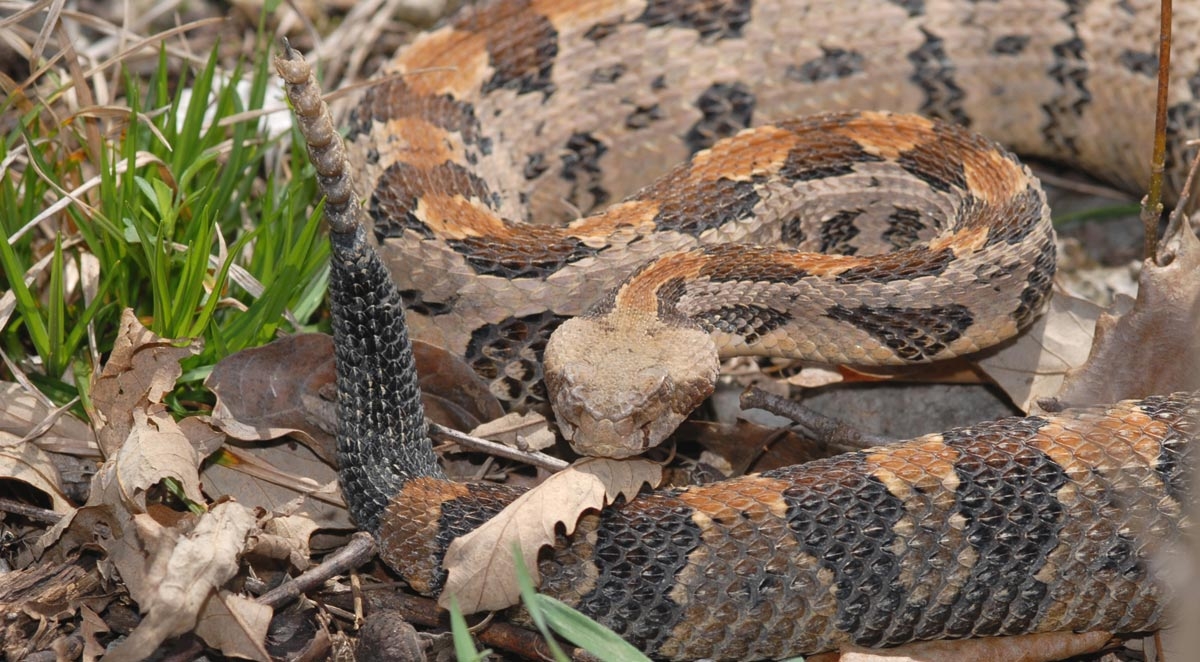Spotting Venomous Snakes In North Carolina
Here’s the good news: of the approximate 37 species of snakes in North Carolina, only six are venomous. These are the:
- Copperhead
- Cottonmouth
- Timber Rattlesnake
- Pigmy Rattlesnake
- Eastern Diamondback Rattlesnake
- Eastern Coral
In general, you want to be on guard for a few telltale signs that a snake is venomous:
- A triangular or diamond-shaped head. Non-venomous snakes typically have a tapered head.
- Oblong pupils that look like slits. The pupils of non-venomous snakes are usually round.
- A thick body. Again, most non-venomous snakes are thin.
Now, we don’t want to be close enough to a snake to look into its pupils! Luckily, there are a few other ways to identify those that can do you serious harm. Let’s take a look at the six snakes that share the great state of North Carolina with us.
1. Copperhead
The copperhead is the most common venomous snake in the state - and the cause of most bites. Fortunately, half of bites cause only mild swelling and pain and more severe cases can be treated effectively. In any case, don’t wait to get medical help!
Copperheads are brownish and have “hourglass” patterns of darker tan bands. Their “copper” color helps them camouflage themselves, which is part of the reason so many people are struck. Adults are up to 3 feet long, and you’ll notice the triangular head. If you see a bright yellow tail, it means the copperhead is under one year. Steer clear.
2. Cottonmouth
The cottonmouth looks similar to the copperhead but features olive or dark skin with darker bands. Some have dark, unpatterned skin. If they open their mouths, you’ll see a white cottony interior. Like the copperhead, young cottonmouths have bright yellow (or greenish) tails. Adults are usually about 3-4 feet long but can grow up to 6 feet. Watch out for them in and around freshwater. Typically, the severity of the bite is comparable to that of a copperhead.
3. Timber Rattlesnake
While coloration varies, the timber rattlesnake has light skin with dark bands. There is also that distinctive rattle on the end of the tail, and adults grow to about 4 feet. They prefer forest environments, and their bites are more severe than the copperhead and cottonmouth. Seek medical help immediately if bitten.
4. Pigmy Rattlesnake
As the name implies, the pigmy rattlesnake is smaller than the other venomous snakes in North Carolina. They reach about 1-2 feet and have gray, pink, or red skin with dark spots. Found mostly in the southeastern part of the state, they prefer forests. They have a rattle as well, which emits a buzzing sound rather than a characteristic rattle.
Bites are an emergency. Act fast to stay safe.
5. Eastern Diamondback Rattlesnake
Found in southeastern North Carolina, the eastern diamondback is the largest rattlesnake in the Americas, as well as the heaviest. They reach 4-5 feet long (and sometimes larger) and strike fear into hearts with their terrifying rattle. Eastern diamondbacks have yellowish or grey skin with dark diamond patterns outlined in black. Again: do not delay in seeking emergency treatment!
6. Eastern Coral
The eastern coral is the rarest snake of those we’ve mentioned. Bites are far less common - but they are far more severe. They can trigger respiratory failure as their venom interferes with the central nervous system. This can be fatal.
Here’s where a rhyme you probably heard all your life comes in handy: “Red on black, a friend of Jack. Red on yellow, kill a fellow.” This refers to the bands on the eastern coral snake; the distinctive pattern shows red on yellow.
Snake Problem? Call Rid-a-Bug
While snakes have been “demonized” by countless films and television shows (Snakes On a Plane, anyone?), they are part of our natural habitat. They are not evil or bad - but they can be dangerous. It is best to steer clear and to keep your property and home free from venomous snakes. They may take up residence in crawl spaces, basements, attics, pantries, in and around woodpiles or rock piles, and in shrubbery and underbrush.
Rid-a-Bug’s experienced professionals can humanely remove venomous snakes from your property. Doing so on your own is dangerous, and your safety - and that of your family - is always our first priority. Contact our team today for help handling this risk effectively.

